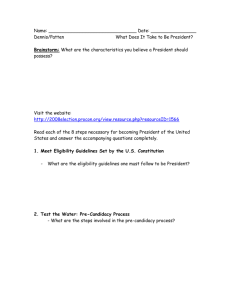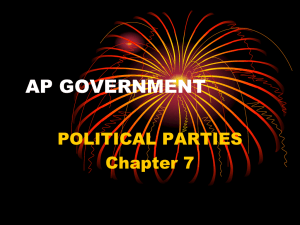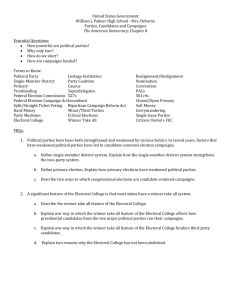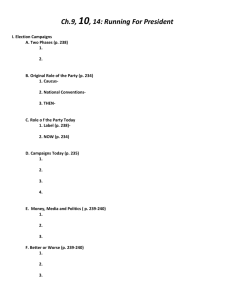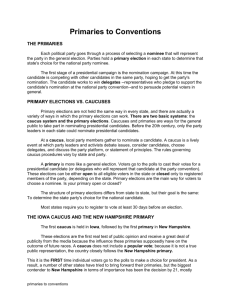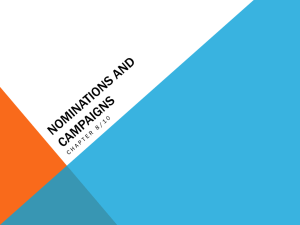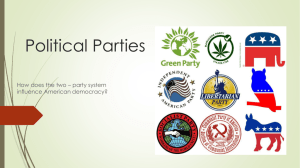Linkage Institutions: III
advertisement
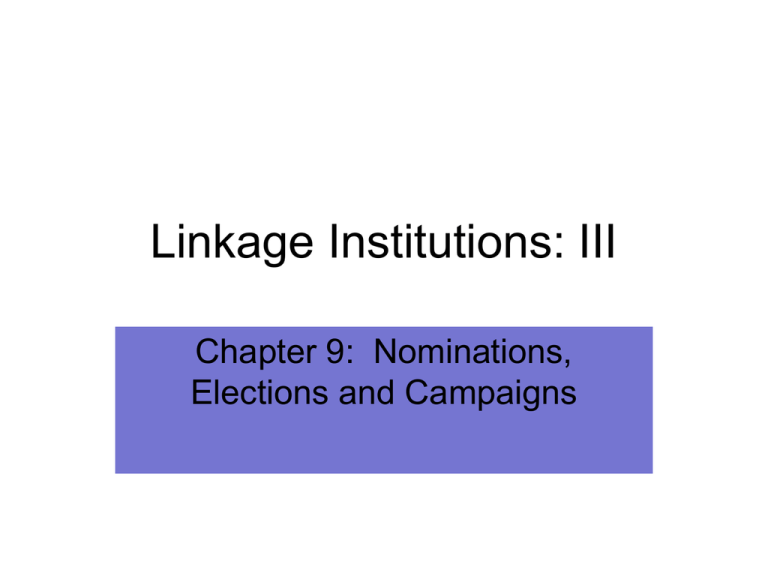
Linkage Institutions: III Chapter 9: Nominations, Elections and Campaigns The evolution of campaigns 1. Election campaign: an organized effort to persuade voters to choose one candidate over another for the same office - Political parties USED to conduct all phases of an election campaign (as recently as 1950s) - Now they are CANDIDATE CENTERED - Candidates contract for polls and consultants - Candidates communicate through media - Campaign for nomination and election, not just election The evolution of campaigns Today • http://www.fec.gov/disclos urep/pnational.do;jsessio nid=9EBCC193FA1658B B8312C282E9EEA005.w orker2 1800 The evolution of campaigns Modern Campaigns - Parties have more control on delegate selection - Campaigns are two stages 1. Nominating candidate 2. Getting candidate elected - Parties basically provide funds and services for candidates Nomination Process-Facts 1. Interesting facts: • No mention in Constitution!! • It involves an election by party voters 1. In most countries, local party leaders choose candidates with approval of national leaders 2. US, each state is entitled to make its own laws governing the nomination process! So we have a lot of ways to nominate a person:) Nomination ProcessCongress and State 1. Most used nomination tool= primary - Primary election: election conducted with a political party to select candidates who will run for public office in next election. Nomination ProcessCongress and State • IN both parties, only about ½ of the regular party voters bother to vote in any given primary (those this varies greatly) – Primary voters hold extreme views? • Not necessarily – Primary voters subdue their views to pick the better faring candidate, rather than personal pick? • Decline in competition for party nomination: 25% of statewide candidates receive serious primary competition (gerrymander?) Nomination Process-Congress and State Examples: Nomination ProcessCongress and State - Major types of primary elections? - Closed: voters must declare their party affiliation before they are given the primary ballot on voting day - Modified: allows individual state parties to decide whether to permit Independents to vote and what offices - Open: voters need not declare their party affiliation and can choose one party’s primary ballot on voting day- Modified: allows Independents to vote in party primary Nomination ProcessCongress and State Examples Nomination ProcessPresident 1. Parties formally choose nominees at national conventions - Democratic: July 25-28,2016 (Philadelphia) - Republican: July 18-21, 2016 (Cleveland) - Constitution: October 30-31, 2015 - Libertarian: May 26-30, 2016 (Orlando) History of Presidential Nomination Process -1800-1824: Caucus of congressional members for POTUS Caucus: local meeting selects delegates for county level, county level to state level, state leads to national level -1832: Nomination conventions (national) for POTUS candidates--> delegates selected by state legislatures History of Presidential History of Nomination Process Nomination Process - Progressive Era leads to states creating primaries for POTUS as well. 1910: Oregon 1912= 1st election where primary POTUS used 1913: 17th amendment--> direct election of senators rather than a caucus selection by state legislatures! Gets rid of political bosses determining candidates and encourages more popular support History of Presidential History of Nomination Process Nomination Process In summary: before 1968 -Party dominated -few primaries -short campaigns -easy money -limited media coverage -late decisions - open conventions History of Presidential History of Nomination process Nomination Process So what happened to change the process!!! 1968 Democratic Convention inside politics 1. LBJ decides to not run due to Vietnam/Civil Rights protests 2. Demonstrators protest outside of Chicago national convention and Chicago police intervene 1. Protests due to strong support of McCarthy(antiwar) for POTUS nominee, but Dems nominate LBJ VPOTUS Humphrey= vietnam! 3. Media (including a roughed up Dan Rather) History of Presidential History of Nomination Process Nomination Process So…McGovern-Fraser commission (led by D Senator McGovern) sets new rules for 1972 recommending that ALL states adopt a new rules to assure wider participation in primaries to help national convention select party delegate for POTUS election (so no more riots) So… states adopt the policy for POTUS Republicans follow suit soon after… History of Presidential History of Nomination Process Nomination Process In summary: since 1972 - Candidate dominated - Many primaries - Long campaigns - Difficult fundraising - Media focused - “front loaded”:states moving primaries/caucuses earlier in calendar to gain media/candidate attention (IOWA/NH!!) - Closed conventions Nomination- choosing delegates for the national convention Delegate: a person sent or authorized to represent others, in particular an elected representative sent to a conference. •These are the people that choose the party’s official nominee for president -Before 1968= party dominated -Since 1972= primary/caucus/candidate dominated Nomination- choosing delegates for the national convention • How do we select these delegates?’ – All states use a primary or a caucus to determine delegates for National Convention after the 1968 fiasco Nomination- choosing delegates for the national convention Presidential Primary: special primary used to select delegates to attend the party’s national nominating convention, which in turn nominates the presidential candidate -Democratic primaries are usually proportional -Republican primaries are usually winnertake-all Nomination- choosing delegates for the national convention • Convention arrangements: National committee selects a day, time and city for the nominating device of candidate – Republicans: Cleveland, OH July 2016 – Democrats: Philadelphia, PA July 2016 (Columbus was #2) • Apportionment of delegates: national committee tells each state how many delegates they can send to the national convention in the summer weird formula based on population and electoral votes Nomination- choosing delegates for the national convention • Selection of delegates: – Republicans allow states to determine selection process of delegates • Ohio-66 delegates application process – Democrats have adopted several rules that states have to follow to broaden participation to women and minorities • Ohio- 97 delegates, 9 alternates application process Nomination- choosing delegates for the national convention • Democratic Primary (Pledged and unpledged delegates) – Pledged: elected to his or her position with the understanding that he or she will support a particular candidate (80% of delegates) NOT TECHNICALLY BOUND – Unpledged (superdelegates) unique to Democrats: pledge allegiance to a candidate before convention, but can change mind (20% of delegates) Democratic National Committee (governors, party leaders, etc.) Nomination- choosing delegates for the national convention • In primary states, voters are actually voting for a candidate's slate of pledged delegates. The number of delegates who get to attend the national conventions is proportional to the candidate's share of the primary vote. – These people file with the state party to be delegates (look at Ohio’s on my website) Nomination- choosing delegates for the national convention • Republican primary (Pledged and Republican National Committee delegates) – Pledged: POTUS candidates preapprove delegates and are pledged (80-85%) – RNC: unpledged delegates by virtue of their position(15-20%) See Democratic Party Nomination- choosing delegates for the national convention • In primary states, voters are actually voting for a candidate's slate of pledged delegates. The number of delegates who get to attend the national conventions is winner take all of the primary vote. – These people file with the state party to be delegates (look at Ohio’s on my website) Nominationchoosing delegates for Nomination of POTUS the national convention Option 2: Caucus/Convention: method to select delegates to attend a party’s national convention • In general, this is a local meeting that selects delegates for a county-level meeting, that leads to a state-level meeting. • State Convention selects national convention delegates Nominationchoosing delegates for History of nomination process the national convention Alternative methods 1. Submission of a certain number of registered voters’ signatures 2. Self nomination Used by 3rd parties, independents and R/D that do not win party nomination Nominationchoosing delegates for Nomination of POTUS the national convention Primaries seem to be the most “open” method for choosing delegates. -POTUS primaries generate 80% of delegates -Nearly all delegates selected in primaries are publicly committed to specific candidates -Can easily tell before the conventions who will be the nominee - Front loading: states’ practice of moving delegate selection primaries and caucuses earlier in the calendar year to gain FRONTLOADING! In 2008, more than 1/2 of the delegates to both conventions were chosen by February 5th !!!! (= dropout of race) In 2012, more than ½ of the delegates to both conventions were chosen by March 6th FRONTLOADING! IOWA: holds 1st caucus at the end of January (moved to January 3 in 2012!!!)--> forces out unpopular nominees NEW HAMPSHIRE: holds 1st primary in February(moved to January 10 in 2012!!-->tests the appeal of the front runners with ordinary voter FRONTLOADING!!! MARCH: 2008= THE GREAT TSUNAMI OF 24 STATES!!!Now many of them are moved back! Super Tuesday= March 6 as 10 states have primaries April/May: are 2-5 states a week June: California, Montana, New Jersey, New Mexico, South Dakota,Ohio, Utah primaries 2016 Line UP February: Iowa and New Hampshire March: Is the wave of primaries/caucuses including OHIO --Most primaries and caucuses are finished April: a few May: a few June: a few (including California) 2016 Line UP Campaigning for Nomination “Invisible Primary”: the process of preparing for the next election in which prospective candidates quietly begin lining up political/financial support for their likely race 4 years later - exploratory campaign committees start registering with the FEC Campaigning for Nomination Iowa and New Hampshire have been the testing grounds on candidate popularity - IOWA: gets rid of candidates rejected by party faithful - NH: tests Iowa frontrunners to ordinary party voters. Concerns: Is Iowa and New Hampshire really a reflection of the US popular vote? Campaigning for Nomination • Examples Primary centered nomination consequences 1. When no incumbent, numerous choices (2016!!!) 2. Incumbent POTUS usually encounter little to no opposition 3. Iowa and NH do matter 4. Candidate favored by most Party ID’s usually win party nomination 5. Candidates usually win on own, not through national party organization Sabato’s List http://www.centerforpolitics.org/crystalball/20 16-president/ st nd Republicans:1 , 2 3rd tiers • • • • • • • • • • • Donald Trump Ben Carson Carly Fiorina Mike Huckabee Chris Christie Rand Paul Bobby Jindal Rick Santorum Lindsay Graham George Patakai Jim Gilmore and Democrats • Hillary Clinton • Martin O’Malley • Larry Lessig • Joe Biden- not running (October 21, 2015) Elections- general GENERAL ELECTION: a national election held in November in evennumbered years. 1. All seats in House, 1/3 of Senate and lots of states and local offices filled 2. POTUS= every 4 years (2008, 2012, 2016) 3. Congressional/midterm/off-year= in between POTUS election (2010, 2014) POTUS elections and Electoral College Electoral College: structure 1. State EC votes= senators + reps – 535 + 3 DC 2. Candidate needs 270 to win 3. No majority? House decides (each state=1 vote) – 12th (1804): corrects the tie possibility (P/VP) because they run as pairs in single party 4. Every decade, # of electors change based on congressional reapportionment done by census (WHO ARE THESE PEOPLE?- POTUS and Electoral College Electoral College: politics 1. Since 1860: all states have selected electors by popular vote 2. 2000: Florida legislature threatened to select electors themselves on basis of pre 1860 precedent (Bush v. Gore) HANDOUT 3. Electoral College is Federal, not National 1. Except for ME and NE, a candidate who wins a state wins all electoral votes 2. 2000: possible to win popular and not Electoral Electoral College: Abolish it? 1. Must distinguish between the electoral “college” and the “system” of electoral votes 2. Electoral college is merely the set of individuals empowered to cast the state’s electoral votes – FAITHLESS ELECTORS: electors who break their pledge to a candidate when they gather at the state capital to cast their written ballots – Voters today have reason to oppose the need for a body of electors to translate their decision Electoral College: Abolish it? 3. The Electoral Vote system – Many reformers argue for majoritarian method for choosing POTUS – But system had not had contradictory impact since 1888 • • In elections from 1888 to 2000, the EC magnified the victory margin 2000 election highlighted the fact that a candidate winning the popular vote may still lose presidency Electoral College: Abolish it? 4. There are 3 lines of argument that support selecting a president by Electoral votes – Federal form of gov’t as embodied in the Constitution weighs small states more in the vote (2 senators/state) – Electoral system encourages POTUS candidates to campaign on foot and in rural areas, rather than just via TV – Focusing on only the popular vote would increase the potential problems of a nationwide recount in a close election (multiplying the problems of Florida 2000 by fifty) Electoral College: Abolish it? 5. Public opinion is opposed to EC – – – Does not understand process 2000 Technology is more efficient Reforms?? Congressional Elections 1. Candidates for presidency are listed at the top of the ballot, followed by candidates for other offices – – Straight-ticket: in voting, a single party’s candidates for all offices Split-ticket: in voting, candidates from different parties for different offices 2. In recent years, elections have resulted in divided government: one party controls presidency, one controls one or both houses of Congress Congressional Elections 3. 1st past the post elections: (British term) elections conducted in single member districts that award victory to candidate with the most votes – In congressional elections, this means that the party that wins the most votes tends to win even more seats than projected due to % of vote – Both parties do well and are hurt by this Congressional Elections • Example Campaign-political context 1. Incumbent, challenger or open election? – Incumbent= “easier win” – Challenger= seeks to replace the incumbent – Open election= lacks incumbent 2. Characteristics of state or district – Bigger, more populous, more diverse= more complicated/$$$$ campaign – Party preference of electorate ? Campaign- Political Context • Example CAMPAIGN FINANCE!!! SEE HANDOUT!!! 1. Campaigns can boil down to $$$, but does not ENSURE success – Mitt Romney 2008 • Raised more $ than his opponents, but did poorly in Iowa/NH and withdrew early CAMPAIGN FINANCERegulations 1. FECA (1971) until 2002 – FEDERAL ELECTION COMMISSION (FEC): bipartisan fed. Agency of 6 members who oversees financing of national election campaigns How FECA regulated… • Charged with: 1. Enforce contribution limits 2. Require disclosure on spending 3. Admin public finance of POTUS campaign • Limit PAC contributions How FECA regulated… • Limit individuals/organization contributions for federal office 1. HARD MONEY: DIRECT CONTRIBUTION TO CANDIDATE’S ELECTION 2. SOFT MONEY: DONATION TO PARTY COMMITTEES FOR CAPITAL AND OPERATIONAL EXPENSES (NOT TO CANDIDATES) • Limits on hard money were challenged on basis of free speech (BUCKLEY V. VALEO 1975) • • • SC upheld hard money limits SC struck down limits on expenses by candidate FEC can only regulate ads for or against language Bipartisan Campaign Reform Act of 2002 (BCRA) 1. Went into effect 2004 election 2. Raised previous limits on individual spending and adjusted for inflation 3. Did not raise PAC contribution limits 4. Eliminated soft money contributions 5. Banned orgs from running issue ads that named candidates before an election Bipartisan Campaign Reform Act of 2002 (BCRA) • Examples BCRA and 527s 527??: committees named after sec. 527 in IRS code (tax exempt status in election campaigns if they are unaffiliated with political parties and take positions on issues, not specific candidates. • Can spend unlimited $$ for media as long as they do not expressly advocate a candidates election or defeat !! BCRA and 527s • Pre BCRA $151 million (2002) to Post BCRA $424 million (2004) • Landmark USSC cases on Campaign Finance – McConnell v. FEC (2002) – Shays v. FEC (2007) – FEC v. Wisconsin Right to Life (2007) – Citizens United v. FEC (2010) BCRA and 527s • Many groups no longer organize as 527s – 501 social welfare org: groups of IRS code that operate for promotion of social welfare= they are exempt from reporting donors if they spend money on issues, not candidates! • EFFECTS of BCRA – Parties develop infrastructure (ex. Internet, direct mail) to raise money money from small donors – Raised more hard money than combined hard/soft from before… so BCRA= increased campaign money! Public Financing of POTUS 1. FECA (1974): provided public funding for POTUS election campaigns (still under BCRA) 2. Primary season funding – FEC matched $ raised – All candidates (1976-1996) accepted and the associated spending limits – 2000= beginning of candidates not accepting public= no spending limits Public Financing of POTUS Examples Public Financing of POTUS 3. Party Candidates (1976-2004): All candidates accepted and the associated spending limits – 2004= beginning of candidates not accepting public= no spending limits Public Financing of POTUS • Examples Future POTUS candidates unlikely to accept public funding limits! STRATEGIES AND TACTICS Strategy= broad approach to persuade citizens to vote for the candidate Tactic= content of the messages and way they are delivered Basic Strategies: 1. Party-centered: voter partisan id 2. Issue-oriented: seek support of groups=issue 3. Candidate-oriented: personal quality 4. Tailored to political context 5. Use info obtained by professionals to develop/implement strategy MEDIA STRATEGY! 1. News coverage is valuable – Free?? – Seems objective to audience 2. Incumbents have the advantage 3. Effective campaigns recognize the limitations of both news media and audience 4. National news tend to focus on the “horse race” Advertising the Candidate 1. Objective of paid advertising – Name recognition – Promotion of virtues – Attack the opponent/play on emotions Watch ads for past candidates on living room candidate 2. Most ad uses electronic media continued 3. Political ads contain more substance than many believe – Policy positions may be deceptive – Both attack/contrast ads carry more policy info than pure advocacy ads • • Attack= negative Contrast= criticize opponent and advocate positive of sponsored candidate – Media may report controversial ads as news – Finding about impact of neg ads are ambiguous – BCRA contains provision to reduce neg ads--> candidates must announce that they “approve” any ad run by their campaign INTERNET USE 1. 1992-2002: develops as a campaign medium 2. Fast, easy and cheap 3. Voters use the internet a lot!! 4. Online ads small on campaign $$ because local TV reaches average voter better Voter choices… 1. Party identification 1. More than 1/2 decide how to vote before party convention ends in summer 2. Early vote decision usually = vote according to party id 3. Defection usually by candidate attributes/issues 4. Characteristics of vote for winning POTUS • Gains the votes of nearly all of those who id with party • Takes some of his opponents’ id • Wins most of the independents Voter choices… 2. Issues and policies – Candidates seek to exploit issues they think is important to voters – Challengers campaign by pointing out problemss and promising to fix – Incumbents try to campaign on accomplishments Voter choices… 3. Candidate attributes – Esp. important when voters lack info about past behavior and policy stands – Some voters fall back on their beliefs about religion, gender and race to judge candidate Voter choices… 4. Evaluating the voting choice – Rational voting= we vote based on performance and proposed policy – Studies= candidate attribute/party more important than issues – Correlation b/w issue position and party id – Alignment of party and ideology has increased with congressional voting Voter choices… 5. Campaign effects – TV campaign • “sound bites”= candidate can not rely on news to relay message • Entertainment coverage? • Fight mostly through tv ads • Adds target “swing” states – Debates • Fixture since 1976 • Incumbents reluctant unless on own terms…

